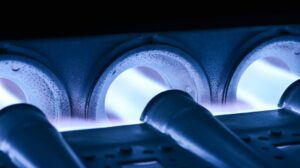
When we talk about gas furnaces, it can sound like we’re saying that they are dangerous. This is not the gas–gas-powered heating systems are not inherently dangerous. However, when they’re not properly cared for, certain components within them can become dangerous. In particular, the heat exchanger.
In a gas-powered furnace, the heat exchanger is where combustion gasses collect in order to heat the air. And if these gases are allowed to escape through a damaged heat exchanger, your household could be exposed to harmful fumes, like carbon monoxide.
Read on to learn more, and please don’t hesitate to contact us if you suspect you need furnace repair.
What Does the Furnace Heat Exchanger Do?
The heat exchanger component of your furnace is the part that’s actually responsible for heating up the air that travels through your ductwork and then into your household. Once the furnace burners ignite, they produce hot combustion gasses that are collected inside the heat exchanger. The component itself looks like a metal, clamshell-shaped chamber, or it can be a series of chambers.
The gas within the heat exchanger heats up the metal walls, and then the air coming from the blower fan goes over the heat exchangers and picks up the radiant heat, to disperse it into your living space. Essentially, the combustion gas is what’s responsible for actually heating your home, but it doesn’t make contact with your indoor air.
Of course, unless the heat exchanger is damaged. A fully functional heat exchanger system allows combustion byproducts to vent out through a flue outside of the home, and a cracked heat exchanger could potentially enable gas to enter your home.
What’s Harmful About a Cracked Heat Exchanger?
Since the metal shell of a heat exchanger contracts and expands as it cools down and heats back up, the strain of doing this repeatedly can eventually cause microscopic fissures. Even though you can’t see these tiny cracks, every time your furnace cycles on, the metal will expand, and then gas can leak out. In this case, that means there is a risk of exposure to the more harmful type of gas: carbon monoxide (CO).
In the best-case scenario, CO exposure can lead to headaches, minor dizziness or lightheadedness, and sleepiness. Enough CO exposure, however, can lead to even worse symptoms, and even fatalities. So it’s vital that you have this problem fixed right away.
How Do You Know If You Have a Cracked Heat Exchanger?
The #1 answer to this question is “schedule timely maintenance.” You should have maintenance done for your furnace once a year. During this appointment, our professionals comprehensively inspect your heating system, checking for any signs of wear and tear that need to be repaired.
A cracked heat exchanger is more common in an aging furnace than in a newer one, but it’s always a good idea to keep up on tune-ups, and also know about other signs that you may have a cracked heat exchanger, such as hearing a clicking noise as the heat exchanger cycles off.
Whether you suspect or know that you’re in need of Whittier furnace repairs, the time to call Greenleaf Heating & Cooling is today!
